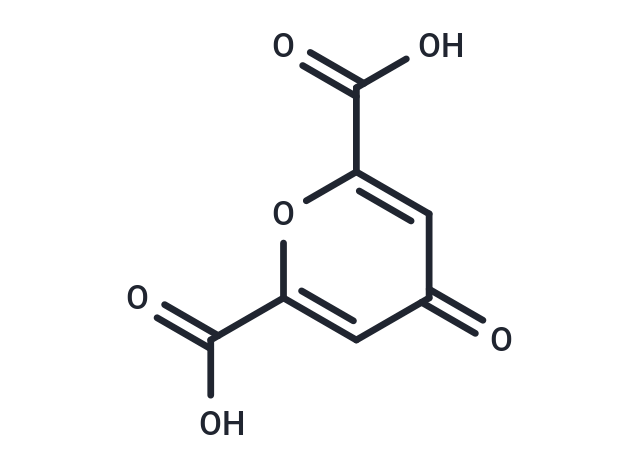Shopping Cart
- Remove All
 Your shopping cart is currently empty
Your shopping cart is currently empty

Chelidonic acid (Jervaic acid) is a component of Chelidonium majus L., used as a mild analgesic, an antimicrobial, an acentral nervous system sedative. Chelidonic acid (Jervaic acid) also shows anti-inflammatory activity.

| Pack Size | Price | Availability | Quantity |
|---|---|---|---|
| 50 mg | $33 | In Stock | |
| 100 mg | $48 | In Stock |
| Description | Chelidonic acid (Jervaic acid) is a component of Chelidonium majus L., used as a mild analgesic, an antimicrobial, an acentral nervous system sedative. Chelidonic acid (Jervaic acid) also shows anti-inflammatory activity. |
| Targets&IC50 | Glutamate decarboxylase (GAD):1.2 μM (Ki) |
| In vivo | Chelidonic acid (0.2, 2 mg/kg p.o.) attenuates allergic reactions induced by ovalbumin in mice by inhibiting caspase-1 activity[3]. |
| Animal Research | female BALB/c mice was Maintained 6-week-old under pathogen-free conditions.?Sensitized mice on days 1, 5, and 14 by intraperitoneal ?injection of 100 μg OVA emulsified in 20 mg aluminum hydroxide and we challenged mice with 1.5 mg OVA.?Chelidonic acid was administrated orally before intranasal .?OVA challenge for 10 days.?Nasal symptoms were evaluated by counting the number of nasal rubs that occurred in the 10 min after OVA. provocation at 10 days after challenge. |
| Alias | γ-Pyrone-2,6-dicarboxylic acid, Jervaic acid, Jerva acid |
| Molecular Weight | 184.1 |
| Formula | C7H4O6 |
| Cas No. | 99-32-1 |
| Smiles | OC(=O)C1=CC(=O)C=C(O1)C(O)=O |
| Relative Density. | 1.4880 g/cm3 (Estimated) |
| Storage | Powder: -20°C for 3 years | In solvent: -80°C for 1 year | Shipping with blue ice. | |||||||||||||||||||||||||
| Solubility Information | DMSO: 4 mg/mL (21.73 mM), Sonication is recommended. | |||||||||||||||||||||||||
Solution Preparation Table | ||||||||||||||||||||||||||
DMSO
| ||||||||||||||||||||||||||

Copyright © 2015-2025 TargetMol Chemicals Inc. All Rights Reserved.